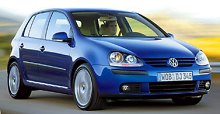 Since
its launch in 1974, Golf had been the King of hatchbacks. The first and
second generations established its reputation as a well-built, fine
handling
hatchback. It earned no. 1 sales in Europe and became a benchmark every
other rival manufacturers take as. Unfortunately, Volkswagen took the
wrong
direction in the making of Golf III (1992) and Golf IV (1997) - it put
priority on quality instead of driving dynamics, conservative instead
of
innovative. As a result, Golf became heavy, uninteresting to drive and
dull to look. In 1998, Ford introduced a revolutionary hatchback -
Focus
- and overtook Golf in worldwide sales chart. Meanwhile, Peugeot 206
also
beat Golf in the European market. In 2002, Golf’s accumulated sales
figure
finally surpassed the legendary Beetle’s, but it had lost its
momentum. Since
its launch in 1974, Golf had been the King of hatchbacks. The first and
second generations established its reputation as a well-built, fine
handling
hatchback. It earned no. 1 sales in Europe and became a benchmark every
other rival manufacturers take as. Unfortunately, Volkswagen took the
wrong
direction in the making of Golf III (1992) and Golf IV (1997) - it put
priority on quality instead of driving dynamics, conservative instead
of
innovative. As a result, Golf became heavy, uninteresting to drive and
dull to look. In 1998, Ford introduced a revolutionary hatchback -
Focus
- and overtook Golf in worldwide sales chart. Meanwhile, Peugeot 206
also
beat Golf in the European market. In 2002, Golf’s accumulated sales
figure
finally surpassed the legendary Beetle’s, but it had lost its
momentum.
In the development of Golf V, Volkswagen rethought the strategy and decided to make it as good to drive as Ford Focus. It took Focus as the benchmark and followed its footprints to switch to multi-link rear suspensions, which is much more sophisticated than the outgoing semi-independent torsion-beam axle. The new suspension geometry allows a higher roll center and better body control - it is stiffer in lateral direction and softer in vertical direction. In this way, body roll is reduced while ride suppleness is improved. The suspension tuning philosophy was also changed. Volkswagen hunted the engineers behind Ford Focus and adopted a strategy similar to the Ford - soft springs / stiff dampers, in contrast to the stiff springs / soft dampers of traditional Volkswagen cars. Volkswagen gets really serious this time.
On the road, the Golf V handles and rides remarkably well - at least in the optional sport suspension setting. The standard suspension setting does not control body movement very well, but the ride is soft and very quiet. Of course, keen drivers must choose the sport setting, which sharpens the chassis and controls body movement as good as Ford Focus. The ride is still refined enough, although not as brilliant as Focus, but the stiffer chassis and superior noise insulation make the Golf far quieter and therefore feeling more expensive. However, in terms of real talent, Ford Focus is still the one to be beaten. Its hydraulic steering feels super communicative. In contrast, Golf’s electric steering lacks feel, although it is precise, well-weighted and free of road shock and vibration - just like sister car Audi A3. Attack a corner, Golf still biases more towards understeer compared with Focus, but you know this is the character of all Volkswagen products. Anyway, the new Golf has finally re-established itself as a fun-to-drive car. Good news.
Externally, the new generation Golf is again bigger than its predecessor - 5.7cm longer, 2.4cm wider, 3.9cm taller and its wheelbase is 6.7cm longer. (Seems that the trend of growth is unstoppable.) The new body is smoother, sleeker and more dynamic than the conservative Mk IV, but drag coefficient of 0.32 is not exactly remarkable. In the Golf V, we can see Volkswagen has renewed its whole line of 4-cylinder engines. The old 1.8-litre 5-valve-per-cylinder engine and its turbocharged version have finally gone. Ditto the strange 2.3-litre V5, whose market positioning was always embarrassing. In place of them is a range of new FSI direct-injection petrol engines. FSI technology gives them an advantage over rivals in terms of fuel economy. The base 1.4FSI pumps out 100hp. 1.6FSI pumps out a remarkable 115hp. It is the 16-valve version of the aluminium-block unit being used by A3. Variable intake manifolds enhance torque delivery. 2.0FSI is the same as A3’s, with variable intake manifolds and twin-balancer shafts. Most people will find the 1.4FSI underpowered, 1.6FSI too noisy and therefore prefer the extra punch and smoothness of the 2.0FSI. However, performance chasers will love the 250hp 3.2-litre VR6 to be launched later. Its performance will surpass the Mk IV’s 2.8 VR6 and match the outgoing R32. In the diesel side, Volkswagen also gives Golf V some strong diesel engines. Like A3, there is a 105hp 1.9TDI 8V and 140hp 2.0TDI 16V to choose from. From 2005, they will be toppled by a 175hp 2.5TDI. Volkswagen’s diesel engines always provide strong power and torque. What a pity their refinement does not match the best rivals, say, Fiat group’s Multijet family and Ford/PSA’s TDCi / HDi series. Nevertheless, in terms of transmission, Golf is a clear winner. Most of the models are offered with a 6-speed manual gearbox, while the incredibly smooth 6-speed DSG double-clutch transmission is available on 2.0FSI and 2.0TDI and will be compulsory on 3.2 V6. Overall
speaking, Golf is a better, more modern hatchback than Ford Focus - our
winner of the class for the past 5 years. It is roomier, quieter and
feels
more expensive. It has better engines and drivetrains. Now it even
rides
and handles close to the level of Focus. Its talents finally matches
its
reputation. |
| The above report was last updated on 12 Dec 2003. All Rights Reserved. |
 The
new chassis also improves handling and ride. It is built on Volkswagen
Group’s A5 platform, first introduced by Touran and then Audi A3, and
will
be shared by many other Seats and Skodas in the future. The new chassis
is 80% up in torsional rigidity. This not only reduces NVH but also
improves
the precision of handling. The A5 platform also employs a new electric
power steering for the benefit of lightness, low energy consumption,
free
of kickback and low price. So, how does it handle and ride in reality?
The
new chassis also improves handling and ride. It is built on Volkswagen
Group’s A5 platform, first introduced by Touran and then Audi A3, and
will
be shared by many other Seats and Skodas in the future. The new chassis
is 80% up in torsional rigidity. This not only reduces NVH but also
improves
the precision of handling. The A5 platform also employs a new electric
power steering for the benefit of lightness, low energy consumption,
free
of kickback and low price. So, how does it handle and ride in reality?
 Volkswagen
admitted the 4-link suspension is expensive, but it is essential to
make
Golf V matching the handling and ride of Focus. It would rather save
some
money elsewhere, such as the cabin. Yes, the Golf V’s interior is no
longer
as expensive as Golf IV. For instance, the lower half of the dashboard
is made of hard plastic, leaving only the upper half as soft-touch
plastic.
This is still a nice cabin, feeling more expensive than most rivals,
however.
Better news is that the cabin is now roomier, especially at the back,
being
noticeably roomier than Renault Megane and marginally better than
Focus.
Strangely, the Golf’s wheelbase is shorter than them, but its extra
width
and height and better use of space allow it to offer more legroom,
shoulder
room and headroom to the rear passengers. Well done!
Volkswagen
admitted the 4-link suspension is expensive, but it is essential to
make
Golf V matching the handling and ride of Focus. It would rather save
some
money elsewhere, such as the cabin. Yes, the Golf V’s interior is no
longer
as expensive as Golf IV. For instance, the lower half of the dashboard
is made of hard plastic, leaving only the upper half as soft-touch
plastic.
This is still a nice cabin, feeling more expensive than most rivals,
however.
Better news is that the cabin is now roomier, especially at the back,
being
noticeably roomier than Renault Megane and marginally better than
Focus.
Strangely, the Golf’s wheelbase is shorter than them, but its extra
width
and height and better use of space allow it to offer more legroom,
shoulder
room and headroom to the rear passengers. Well done!
 The
170hp Golf GT is a new addition to the Golf range, slotting between the
150 hp 2.0 FSI and 200hp GTI. That's not a big news. What made the
headline is that it introduced the world's first production
supercharger-turbocharger hybrid system. Called "Twincharger", the
system combines the benefit of supercharger (i.e. low rev power) and
turbocharger (i.e. high end power) and deliver a flat power band.
The
170hp Golf GT is a new addition to the Golf range, slotting between the
150 hp 2.0 FSI and 200hp GTI. That's not a big news. What made the
headline is that it introduced the world's first production
supercharger-turbocharger hybrid system. Called "Twincharger", the
system combines the benefit of supercharger (i.e. low rev power) and
turbocharger (i.e. high end power) and deliver a flat power band. We
should praise the recent efforts by Volkswagen to reduce fuel
consumption and CO2 emission. It is the first mass production car maker
replacing the majority of its biggest selling 1.6-2.0-liter engines
with downsized turbocharged engines. This mean from now on all Golf and
Passat will use the new 1.4 TSI engines instead of the previous 1.6 FSI
and 2.0 FSI. The 1.4 TSI family consists of 3 versions: 122hp, 140hp
and 170hp. We talked about the 170hp version and mentioned the 140hp
unit more than two years ago (see above). Both of them employ
twincharger (which consists of turbocharger and mechanical
supercharger) to produce a specific output exceeding 100 hp per liter.
However, for the majority of Golf buyers, the twincharger is probably
too expensive. That is why later on Volkswagen introduced the 122hp
version with only a turbocharger. It is designed to replace the 1.6 FSI
as the biggest selling engine in the Golf lineup.
We
should praise the recent efforts by Volkswagen to reduce fuel
consumption and CO2 emission. It is the first mass production car maker
replacing the majority of its biggest selling 1.6-2.0-liter engines
with downsized turbocharged engines. This mean from now on all Golf and
Passat will use the new 1.4 TSI engines instead of the previous 1.6 FSI
and 2.0 FSI. The 1.4 TSI family consists of 3 versions: 122hp, 140hp
and 170hp. We talked about the 170hp version and mentioned the 140hp
unit more than two years ago (see above). Both of them employ
twincharger (which consists of turbocharger and mechanical
supercharger) to produce a specific output exceeding 100 hp per liter.
However, for the majority of Golf buyers, the twincharger is probably
too expensive. That is why later on Volkswagen introduced the 122hp
version with only a turbocharger. It is designed to replace the 1.6 FSI
as the biggest selling engine in the Golf lineup. 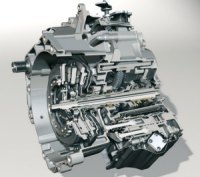 As
expected, the 122hp 1.4 TSI engine is more frugal (44.8mpg vs 42.1mpg)
and cleaner (CO2 emission 149g/km vs 161g/km) than the old 1.6 FSI.
However, Volkswagen is not content. Recently it developed a new 7-speed
DSG gearbox to enhance fuel economy further. Unlike the first
generation 6-speed DSG, this one employs dry clutches instead of wet
clutches in order to reduce size, weight, friction and most important,
cost. This mean more Golf buyers can afford the new DSG. The dry-clutch
DSG could take up to 250 Nm (184 lb-ft) of torque, so it is a perfect
match to all three 1.4 TSI engines. This leave the original 6-speed DSG
to serve the torquey diesel, 2.0TFSI and VR6.
As
expected, the 122hp 1.4 TSI engine is more frugal (44.8mpg vs 42.1mpg)
and cleaner (CO2 emission 149g/km vs 161g/km) than the old 1.6 FSI.
However, Volkswagen is not content. Recently it developed a new 7-speed
DSG gearbox to enhance fuel economy further. Unlike the first
generation 6-speed DSG, this one employs dry clutches instead of wet
clutches in order to reduce size, weight, friction and most important,
cost. This mean more Golf buyers can afford the new DSG. The dry-clutch
DSG could take up to 250 Nm (184 lb-ft) of torque, so it is a perfect
match to all three 1.4 TSI engines. This leave the original 6-speed DSG
to serve the torquey diesel, 2.0TFSI and VR6. 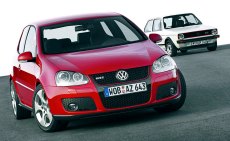 In
1978, Volkswagen brought the world a new kind of vehicle called "Hot
Hatch".
That was Golf GTi. It showed that by using tuned engine and
suspensions,
plus sport seats and a few styling mods, a family hatchback can be
converted
into an exciting yet affordable driver’s car. Golf GTi immediately won
sales success all over the world. Within a few years, a lot of copycat
GTis flooded into the market, though some was really good (e.g. Peugeot
205GTi), Volkswagen Golf GTi remains to be the definitive GTi.
In
1978, Volkswagen brought the world a new kind of vehicle called "Hot
Hatch".
That was Golf GTi. It showed that by using tuned engine and
suspensions,
plus sport seats and a few styling mods, a family hatchback can be
converted
into an exciting yet affordable driver’s car. Golf GTi immediately won
sales success all over the world. Within a few years, a lot of copycat
GTis flooded into the market, though some was really good (e.g. Peugeot
205GTi), Volkswagen Golf GTi remains to be the definitive GTi.
 Open
the bonnet, you will be grateful to see the new 2.0 TFSI engine we
recently
praised in Audi A3 Sportback. This is a gem, unquestionably. A perfect
combination of low-pressure turbo and direct fuel injection technology,
also variable valve timing and variable-length intake manifolds. It
sings
eagerly, runs smoothly and delivers its power strongly. 200 horsepower
is not exactly class-leading, but it can deliver 207 lbft of torque
from
merely 1800rpm, remains steady all the way to 5100 rpm. By the 6500 rpm
redline, it still pulls strongly, and not give up spinning until fuel
cut
out at 7000 rpm. This give the 1330kg Golf GTi a sprint to 60mph in 6.8
seconds. If you choose the excellent DSG gearbox, it can even do that
in
6.6 seconds. It won’t run out of steam until 146mph. At the same time,
the 2.0 TFSI returns a remarkable fuel consumption at 35.3mpg. Can you
name an engine more versatile than this one?
Open
the bonnet, you will be grateful to see the new 2.0 TFSI engine we
recently
praised in Audi A3 Sportback. This is a gem, unquestionably. A perfect
combination of low-pressure turbo and direct fuel injection technology,
also variable valve timing and variable-length intake manifolds. It
sings
eagerly, runs smoothly and delivers its power strongly. 200 horsepower
is not exactly class-leading, but it can deliver 207 lbft of torque
from
merely 1800rpm, remains steady all the way to 5100 rpm. By the 6500 rpm
redline, it still pulls strongly, and not give up spinning until fuel
cut
out at 7000 rpm. This give the 1330kg Golf GTi a sprint to 60mph in 6.8
seconds. If you choose the excellent DSG gearbox, it can even do that
in
6.6 seconds. It won’t run out of steam until 146mph. At the same time,
the 2.0 TFSI returns a remarkable fuel consumption at 35.3mpg. Can you
name an engine more versatile than this one? 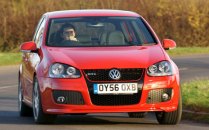 To
celerate the 30 years anniversary of Golf GTI, Volkswagen released this
limited edition whose 2.0TFSI engine has been tuned to deliver 30 more
horsepower than the regular version. That's a total of 230hp and 221
lbft of torque, but still considerably less than the 265hp limit that
Audi S3 proved this engine can handle. No wonder it is almost as
tractable and lag-free as the regular Golf GTI. Once the needle passes
3000rpm, however, the engine produces noticeably stronger punch,
pushing the car from rest to 60 mph in 6.3 seconds (for DSG gearbox),
or 0.3 second quicker than before. Top speed finally breaks the 150 mph
barrier.
To
celerate the 30 years anniversary of Golf GTI, Volkswagen released this
limited edition whose 2.0TFSI engine has been tuned to deliver 30 more
horsepower than the regular version. That's a total of 230hp and 221
lbft of torque, but still considerably less than the 265hp limit that
Audi S3 proved this engine can handle. No wonder it is almost as
tractable and lag-free as the regular Golf GTI. Once the needle passes
3000rpm, however, the engine produces noticeably stronger punch,
pushing the car from rest to 60 mph in 6.3 seconds (for DSG gearbox),
or 0.3 second quicker than before. Top speed finally breaks the 150 mph
barrier.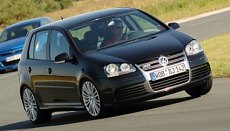 The
origin of R32 can be traced back to the 1991 Golf VR6. It was the grand
father of today's premium hot hatches - Golf R32, Alfa 147 GTA, BMW
130i, Audi A3 V6… and a force running in parallel to the Japanese rally
duo. The Golf VR6, as indicated by its name, introduced a 174 hp
2.8-litre V6 into a hot hatch body normally associated with
four-cylinder engines. This is made possible by the compact,
narrow-angle VR6. It brought BMW-level performance into the hot hatch
world for the first time.
The
origin of R32 can be traced back to the 1991 Golf VR6. It was the grand
father of today's premium hot hatches - Golf R32, Alfa 147 GTA, BMW
130i, Audi A3 V6… and a force running in parallel to the Japanese rally
duo. The Golf VR6, as indicated by its name, introduced a 174 hp
2.8-litre V6 into a hot hatch body normally associated with
four-cylinder engines. This is made possible by the compact,
narrow-angle VR6. It brought BMW-level performance into the hot hatch
world for the first time. Compare
with its predecessors, the latest generation R32 has nothing to
surprise me. In fact, the biggest advancement comes from the Golf V
basis, whose multi-link rear suspensions lifts body control, grip and
at-the-limit behaviour beyond that of the Golf IV without resorting to
very stiff setup like the last generation R32. No wonder you can feel
its ride firm but never harsh.
Compare
with its predecessors, the latest generation R32 has nothing to
surprise me. In fact, the biggest advancement comes from the Golf V
basis, whose multi-link rear suspensions lifts body control, grip and
at-the-limit behaviour beyond that of the Golf IV without resorting to
very stiff setup like the last generation R32. No wonder you can feel
its ride firm but never harsh. 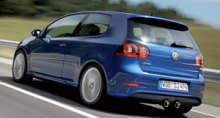 However,
the R32 is not a lot faster than the 200hp GTI. Volkswagen claims it
take 6.5 seconds to accelerate from rest to 60 mph, just 0.3 seconds
quicker than the GTI. The problem lies in weight - the V6 engine, 4WD
hardware, larger brakes and higher equipment level put an additional
180 kg to the body. If you opt for the DSG gearbox, another 30 kg will
be added. Nevertheless, I would say DSG is a worthwhile option, as it
shifts instantly and seamlessly (thanks to the double-clutch pre-select
mechanism). It also reduces 0-60 time to a more competitive 6.2 seconds.
However,
the R32 is not a lot faster than the 200hp GTI. Volkswagen claims it
take 6.5 seconds to accelerate from rest to 60 mph, just 0.3 seconds
quicker than the GTI. The problem lies in weight - the V6 engine, 4WD
hardware, larger brakes and higher equipment level put an additional
180 kg to the body. If you opt for the DSG gearbox, another 30 kg will
be added. Nevertheless, I would say DSG is a worthwhile option, as it
shifts instantly and seamlessly (thanks to the double-clutch pre-select
mechanism). It also reduces 0-60 time to a more competitive 6.2 seconds. Naturally,
the suspensions of R32 are stiffer than the GTI's. It also employs
lower profile tires and bigger wheels. The result is a taut body
control. The Michelin 225/40ZR18s generate masses of grip, the huge
ventilated discs (345mm front and 310 mm rear) provide strong and
reassuring stopping power. Overall, the R32 is a more accomplished
package than BMW 130i, whose chassis setup is either too hard or too
soft.
Naturally,
the suspensions of R32 are stiffer than the GTI's. It also employs
lower profile tires and bigger wheels. The result is a taut body
control. The Michelin 225/40ZR18s generate masses of grip, the huge
ventilated discs (345mm front and 310 mm rear) provide strong and
reassuring stopping power. Overall, the R32 is a more accomplished
package than BMW 130i, whose chassis setup is either too hard or too
soft.